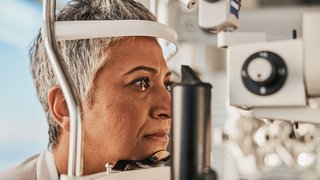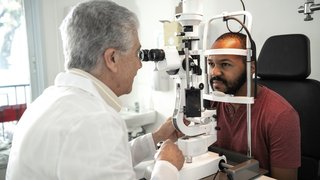New glaucoma therapies improve results and reduce recovery time
March 1, 2023

More than 3 million people in the United States are affected by glaucoma, a disease that increases pressure on the optic nerve, which transmits images from the eye to the brain. Most patients with glaucoma have few or no early symptoms, but if the condition is not treated effectively by lowering intraocular pressure with medication, laser therapy, or surgery, patients can suffer permanent vision loss.
Traditional glaucoma surgery carries the potential risk of temporary or, less often, permanent vision loss, and usually requires a long recovery period with multiple follow-up appointments. Today, however, we can offer patients several new glaucoma medications for lowering intraocular pressure, an office-based laser treatment, as well as minimally invasive glaucoma surgeries (MIGS) that are relatively safe and effective with the potential for quicker visual recovery.
What is the newest treatment for glaucoma?
Medications
Glaucoma treatment usually begins with the use of topical medication to lower intraocular pressure. Some of the newer medications on the market are eye drops called VYZULTA (latanoprostene bunod ophthalmic solution) and Rhopressa (netarsudil ophthalmic solution). VYZULTA is a modification of a current class of medications currently used to treat glaucoma – the prostaglandin analogs. This drug helps lower intraocular pressure by increasing the drainage of fluid (aqueous humor) from the eye.
Rhopressa is part of a new class of drugs used to treat glaucoma called rho kinase inhibitors. It also lowers intraocular pressure by increasing aqueous outflow. Both types of prescription eye drops are applied once a day and pose few, if any, systemic safety concerns.
Laser Treatments
Selective laser trabeculoplasty (SLT) reduces intraocular pressure by stimulating increased outflow of fluid from the eye. SLT offers an improved safety profile compared to older glaucoma laser therapies and may lower eye pressure by as much as 20-30%. It can be used as first-line treatment prior to the addition of glaucoma medications, or as the next step in patients whose glaucoma is uncontrolled by medical therapy. It also can be very useful in patients who have difficulty with their eye drops and are looking for an alternative treatment.
Alternative drug deliveries
Durysta, which incorporates a pellet of bimatoprost, a prostaglandin analog, is injected directly into the anterior chamber of the eye in a safe and painless manner. This pellet dissolves over time and can lower the eye pressure without drops for several months.
Minimally invasive glaucoma surgery (MIGS)
The goal of minimally invasive glaucoma surgery (MIGS) is to reduce intraocular pressure by enhancing the eye’s own internal aqueous humor drainage system. Some MIGS can be performed as standalone procedures, while others are typically done along with cataract surgery in patients with visually significant cataracts and mild to moderate glaucoma.
Several varieties of MIGS are approved by the U.S. Food and Drug Administration (FDA) and are available in the U.S. Typically, MIGS are performed through a small incision in the eye with minimal tissue trauma. They offer a favorable safety profile as well as more rapid visual recovery than traditional glaucoma surgery.
At UT Southwestern, we offer coverage in all aspects of eye care, so if you need help with any other ocular conditions we will easily connect you with the appropriate subspecialist.
To find out whether you or a loved one might need treatment for glaucoma, call 469-306-1070 or request an appointment online.
Total eye health
Each year, our ophthalmologists treat thousands of patients with a wide variety of eye conditions. This high volume provides us with extensive experience that translates to the best possible care for our patients. Ophthalmologists share the expertise of the team and the importance of one-stop, comprehensive eye care at UT Southwestern.











